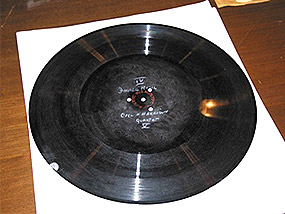
evaluating your collections
1 Motion Picture Film | 2 Sound Recordings | 3 Videotapes | 4 Magnetic Disks and Optical Media
You have explored the mechanisms of deterioration for audiovisual and electronic media and briefly examined the role of external factors in collection deterioration. In this section you will begin to relate this information to your own collections.
IMPORTANT: This examination of your collections is not meant to serve as a formal collection condition survey, but it will assist you in determining which materials need further attention. You may decide that one or more collection condition surveys are required for specific subsets of your film-based or electronic materials (e.g., reel-to-reel tapes, photographic negatives, motion picture films). This type of inspection most often takes the form of an item-by-item survey by a conservator with detailed knowledge of that particular type of collection.
1 Motion Picture Film
Film is very vulnerable to physical damage due to the rigors of projection and handling; this may include tears, damaged sprocket holes, and splices. Film can also suffer from mold growth, which begins at the outer edge and moves into the roll of film, eventually destroying the emulsion. Shrinkage of the film can occur due to low humidity, which may also make the film brittle.
Previous sections have discussed chemical and physical evidence of the deterioration of different film bases. Noting such characteristics will impact priorities and planning for collection materials.
2 Sound Recordings
Sound recordings may be present in a variety of formats in cultural collections. They may include disc recordings, wax cylinders, reel-to-reel tapes, cassette tapes, and CDs. They may be commercial recordings, or they may document lectures, concerts, or other events of importance to an organization, institution, or individual.
|
|
Physical damage to sound recordings includes brittleness, cracking, and decomposition of disc recordings, damage to thin and fragile magnetic tape from playback, distortion of polyester-backed tapes, poor tape pack winding, and damage caused by defective cassette cases.
Chemical damage that may be noted includes sticky shed syndrome, in which a gummy residue is found on the surface of the tape. Sticking or jamming of the tape during playback may also indicate a loss of tape lubricant. In addition, early audiotape may be on acetate, and thus may exhibit evidence of vinegar syndrome, which includes a vinegar odor, curling, or staining. Advanced deterioration will manifest itself through bubbles on the film and separation of the emulsion from the base. Many audio formats are at risk of technical obsolescence, so priority should be given to these materials.
3 Videotapes
Videotapes are frequently found within cultural collections. The most common format is VHS, although others such as Beta and compact formats may also be found. Usually videotapes document events of importance to an organization, institution, or individual. Videotapes have a polyester base, so they are not subject to the deterioration seen in nitrate or acetate film-based materials.
As with audiotapes, chemical damage may include sticky shed syndrome, in which a gummy residue is found on the surface of the tape. Videotapes are also vulnerable to strong magnetic fields. Physical damage may include edge damage or warped tape. Like other magnetic media, videotape should be considered at risk because of its characteristics of deterioration, and because of limited playback equipment.
4 Magnetic Disks and Optical Media
While it is clear that magnetic disks and diskettes, CDs, and DVDs (which are all used to store various types of digital data) have limited physical lifespans, it is difficult to determine the extent of their deterioration by simple observation. If problems are noted when accessing the data or playing the CD or DVD, this should be taken as an indication that the item may be vulnerable to a more serious failure.
However, given the fact that the hardware and software to access these materials will likely become obsolete before the media themselves deteriorate, determining the condition of these materials is not the highest priority. It is very important to gather descriptive information (metadata) about all items determined to be of long-term value. This should include physical details of the format, and the hardware, operating system, and software required to access the data. Data that is of long-term value should be copied and migrated to new formats when necessary. This is addressed in more detail in Session 7: Reformatting and Digitization.

